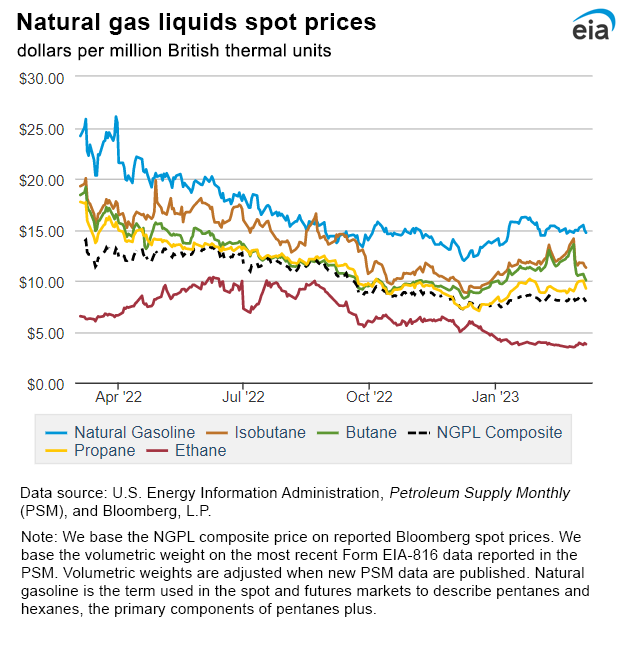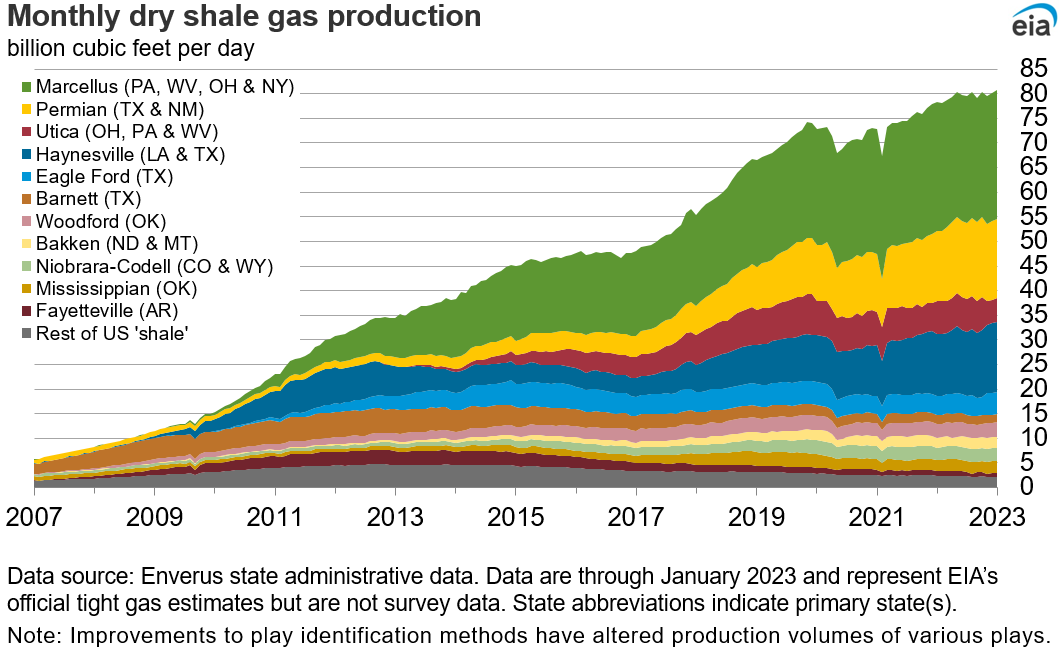In the News:
Liquefied natural gas will continue to lead growth in U.S. natural gas exports
Exports of liquefied natural gas (LNG) will continue to drive growth in U.S. natural gas exports over the next two years, according to our March 2023 Short-Term Energy Outlook (STEO). We forecast that U.S. LNG exports will average 12.1 billion cubic feet per day (Bcf/d) in 2023, a 14% (1.5 Bcf/d) increase compared with last year. We expect LNG exports to increase by an additional 5% (0.7 Bcf/d) next year.
We forecast U.S. LNG exports to rise because of high global demand as LNG will continue to replace pipeline natural gas exports from Russia to Europe. So far this year, mild winter temperatures and fuller-than-average storage resulted in reduced international LNG prices, which could be an incentive for countries to import more LNG, especially more price-sensitive countries in Southeast Asia. The Freeport LNG export terminal's return to service and the new LNG export projects that we expect to be commissioned by the end of 2024 support our forecast increase in exports.
The Freeport LNG terminal, one of seven active U.S. LNG export facilities, can produce 2.14 Bcf/d of LNG on a peak day. Prior to the full shutdown of the facility in June 2022, exports from the facility averaged 1.9 Bcf/d from January 2021 through May 2022, according to our Natural Gas Monthly.
Because of the Freeport shutdown, U.S. LNG exports declined to an average 10.0 Bcf/d from June 2022 through December 2022, after peaking at 11.7 Bcf/d in March. When the new Calcasieu Pass LNG export facility was commissioned, it partially offset the decline in exports from Freeport LNG; exports from Calcasieu Pass have averaged 1.2 Bcf/d since June 2022.
This year, once all three liquefaction units at Freeport LNG return to service, we forecast U.S. LNG exports to exceed 12 Bcf/d, and the United States will remain the world’s largest LNG exporter. We forecast that U.S. LNG exports will increase further, to approximately 14 Bcf/d, by December 2024 because some LNG export projects under construction are expected to start operations by then.
We expect U.S. natural gas exports by pipeline to grow by 0.5 Bcf/d in both 2023 and 2024, mainly because of increased exports to Mexico. Several new pipelines in Mexico—Tula-Villa de Reyes, Guaymas-El Oro, the Mayakan pipeline on the Yucatán Peninsula, as well as some other minor interconnects—are scheduled to come online in 2023–24. We also expect an increase in exports via the Sur de Texas-Tuxpan underwater pipeline to supply the proposed floating liquefied natural gas (FLNG) project off the east coast of Mexico.
Market Highlights:
(For the week ending Wednesday, March 8, 2023)Prices
- Henry Hub spot price: The Henry Hub spot price fell 9 cents from $2.59 per million British thermal units (MMBtu) last Wednesday to $2.50/MMBtu yesterday.
- Henry Hub futures prices: The price of the April 2023 NYMEX contract decreased 26.0 cents, from $2.811/MMBtu last Wednesday to $2.551/MMBtu yesterday. The price of the 12-month strip averaging April 2023 through March 2024 futures contracts declined 14.2 cents to $3.385/MMBtu.
- Select regional spot prices: Natural gas spot prices fell at most locations this report week (Wednesday, March 1 to Wednesday, March 8). Week-over-week price changes at major pricing hubs ranged from a decrease of nearly 2 cents/MMBtu at the Transcontinental Pipeline Zone 6 trading point in New York to a decrease of $3.83/MMBtu at Opal in southwest Wyoming.
- Prices across the West fell this report week, after a rare winter storm that swept across the West Coast and Rocky Mountains last week moved east into the Midcontinent. The price at Sumas on the Canada-Washington border, the main pricing point in the Pacific Northwest, fell $3.51 from $10.67/MMBtu last Wednesday to $7.16/MMBtu yesterday. In the Seattle City Area, temperatures averaged 42°F, 6°F higher than last week, which resulted in 42 fewer heating degree days (HDD) than last week, though temperatures remain 3°F below normal. Total natural gas consumption in the Pacific Northwest declined 11%, or 0.3 billion cubic feet per day (Bcf/d) week over week to an average of 2.9 Bcf/d, according to data from S&P Global Commodity Insights.
- The price at PG&E Citygate in Northern California fell $3.56, down from $12.36/MMBtu last Wednesday to $8.80/MMBtu yesterday. In the Sacramento Area, temperatures averaged 47°F this report week, 3°F higher than last report week. The price at SoCal Citygate in Southern California decreased $3.17 from $11.71/MMBtu last Wednesday to $8.54/MMBtu yesterday. Temperatures in the Riverside Area, east of Los Angeles, averaged 50°F this week, 4°F higher than last week, resulting in 30 fewer HDDs. According to data from S&P Global Commodity Insights, natural gas consumption in California decreased by 11% (0.8 Bcf/d) week over week to an average of 6.9 Bcf/d this week, driven by a 15% (0.6 Bcf/d) decrease in consumption in the residential and commercial sectors. For comparison, natural gas consumption for the same week last year in California (week ending on March 9, 2022) averaged 5.8 Bcf/d, while the price at PG&E Citygate averaged $5.48/MMBtu and the price at SoCal Citygate averaged $4.62/MMBtu.
- In the Northeast, natural gas prices fell this week. At the Algonquin Citygate, which serves Boston-area consumers, the price went down 29 cents from $3.26/MMBtu last Wednesday to $2.97/MMBtu yesterday, bringing the price closer in line with other major hubs in the Northeast. Temperatures in the Boston Area averaged 38°F this report week, 9°F higher than last week, leading to 64 fewer HDDs than last week. In the New York-Central Park Area, temperatures averaged 43°F, which is 3°F higher than normal, resulting in 25 fewer HDDs than normal. Total consumption of natural gas in the Northeast decreased 7% (1.8 Bcf/d) week over week to an average of 22.9 Bcf/d, almost entirely driven by a 13% (1.7 Bcf/d) decrease in consumption in the residential and commercial sectors.
- The price at the Waha Hub in West Texas, which is located near Permian Basin production activities, fell 57 cents this report week, from $2.25/MMBtu last Wednesday to $1.68/MMBtu yesterday. The Waha Hub traded 82 cents below the Henry Hub price yesterday, compared with last Wednesday when it traded 34 cents below the Henry Hub price. On March 3, SoCalGas issued a notice of ongoing remediation on Line 235, which has caused operating capacity from the California-Arizona border into the Los Angeles Basin to be reduced by up to 800 million cubic feet per day since February 16, in turn reducing the deliverability of gas into California from production regions east of the state, including the Permian Basin. The preliminary expected completion date of Line 235 remediation work is March 17, 2023.
- International futures prices: International natural gas futures prices decreased to their lowest levels since July 2021 this report week. According to Bloomberg Finance, L.P., weekly average front-month futures prices for liquefied natural gas (LNG) cargoes in East Asia fell 55 cents to a weekly average of $14.21/MMBtu. Natural gas futures for delivery at the Title Transfer Facility (TTF) in the Netherlands decreased $1.44 to a weekly average of $13.66/MMBtu. In the same week last year (week ending March 9, 2022), the prices in East Asia and at TTF were $43.12/MMBtu and $61.08/MMBtu, respectively.
- Natural gas plant liquids (NGPL) prices: The natural gas plant liquids composite price at Mont Belvieu, Texas, rose by 2 cents/MMBtu, averaging $8.18/MMBtu for the week ending March 8. Ethane prices rose 7%, while natural gas prices at the Houston Ship Channel rose 16% week over week, narrowing the ethane premium to natural gas by 5%. Ethylene spot prices fell 1%, narrowing the ethylene to ethane premium by 5%. Brent crude oil prices rose 2%, while propane prices rose 6%, resulting in a 5% decrease in the propane discount relative to crude oil. The normal butane and isobutane prices fell 15% and 10%, respectively. The natural gasoline price rose 1%.
Daily spot prices by region are available on the EIA website.
Supply and Demand
- Supply: According to data from S&P Global Commodity Insights, the average total supply of natural gas fell by 0.8% (0.8 Bcf/d) compared with the previous report week. Dry natural gas production decreased by 0.1% (0.1 Bcf/d), and average net imports from Canada decreased by 13.8% (0.7 Bcf/d) from last week.
- Demand: Total U.S. consumption of natural gas fell by 6.7% (6.1 Bcf/d) compared with the previous report week, according to data from S&P Global Commodity Insights, as the number of total degree days across the Lower 48 states fell by 13% compared with last report week. Natural gas consumed for power generation declined by 4.2% (1.3 Bcf/d) week over week. Industrial sector consumption decreased by 1.2% (0.3 Bcf/d) week over week, and consumption in the residential and commercial sectors declined by 12.7% (4.6 Bcf/d). Natural gas exports to Mexico increased 1.3% (0.1 Bcf/d). Natural gas deliveries to U.S. LNG export facilities (LNG pipeline receipts) averaged 13.2 Bcf/d, or 0.6 Bcf/d higher than last week.
Liquefied Natural Gas (LNG)
- Pipeline receipts: Overall natural gas deliveries to U.S. LNG export terminals increased by 4.5% (0.6 Bcf/d) week over week to 13.2 Bcf/d, according to data from S&P Global Commodity Insights. Natural gas deliveries to terminals in South Louisiana increased by 1.0% (0.1 Bcf/d) to 8.6 Bcf/d, while deliveries to South Texas terminals increased by 16.5% (0.5 Bcf/d) to 3.4 Bcf/d. Natural gas deliveries to terminals along the East Coast were essentially unchanged.
- Vessels departing U.S. ports: Twenty-five LNG vessels (10 from Sabine Pass; 4 each from Cameron and Corpus Christi; 3 each from Calcasieu Pass and Freeport; and 1 from Cove Point) with a combined LNG-carrying capacity of 92 Bcf departed the United States between March 2 and March 8, according to shipping data provided by Bloomberg Finance, L.P.
- LNG terminals: On March 8, the Federal Energy Regulatory Commission granted Freeport LNG’s request to return its Liquefaction Train 1 and Phase I facilities to service.
Rig Count
- According to Baker Hughes, for the week ending Tuesday, February 28, the natural gas rig count increased by 3 rigs from a week ago to 154 rigs, as 1 rig was dropped in both the Haynesville and the Permian, and 5 rigs were added in unidentified basins. The number of oil-directed rigs decreased by 8 from a week ago to 592 rigs, as 1 rig was added in the Cana Woodford, 3 rigs were dropped in the Permian, 1 rig was dropped in the Mississippian, and 5 rigs were dropped in unidentified basins. The total rig count, which includes 3 miscellaneous rigs, stands at 749, which is 99 more rigs than last year at this time.
Storage
- The net withdrawals from storage totaled 84 Bcf for the week ending March 3, compared with the five-year (2018–2022) average net withdrawals of 101 Bcf and last year’s net withdrawals of 126 Bcf during the same week. Working natural gas stocks totaled 2,030 Bcf, which is 21% (359 Bcf) more than the five-year average and 32% (493 Bcf) more than last year at this time.
- According to The Desk survey of natural gas analysts, estimates of the weekly net change to working natural gas stocks ranged from net withdrawals of 69 Bcf to 98 Bcf, with a median estimate of 85 Bcf.
- The average rate of withdrawals from storage is 24% lower than the five-year average so far in the withdrawal season (November through March). If the rate of withdrawals from storage matched the five-year average of 5.0 Bcf/d for the remainder of the withdrawal season, the total inventory would be 1,891 Bcf on March 31, which is 359 Bcf higher than the five-year average of 1,532 Bcf for that time of year.
See also:
Top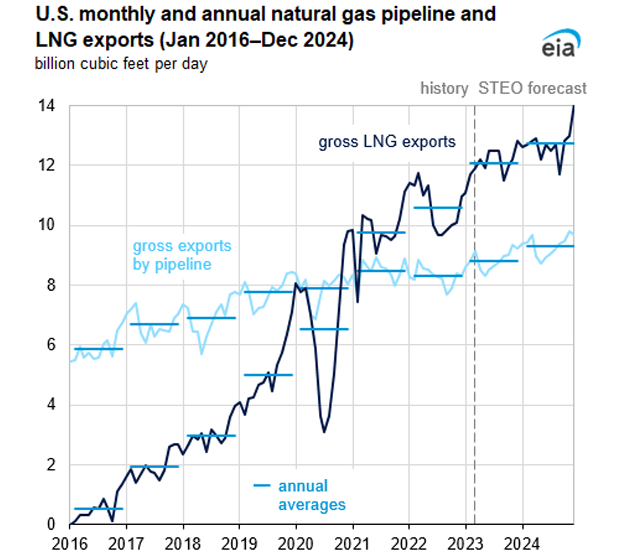
Data source: U.S. Energy Information Administration, Short-Term Energy Outlook (STEO) and Natural Gas Monthly
Note: LNG=liquefied natural gas
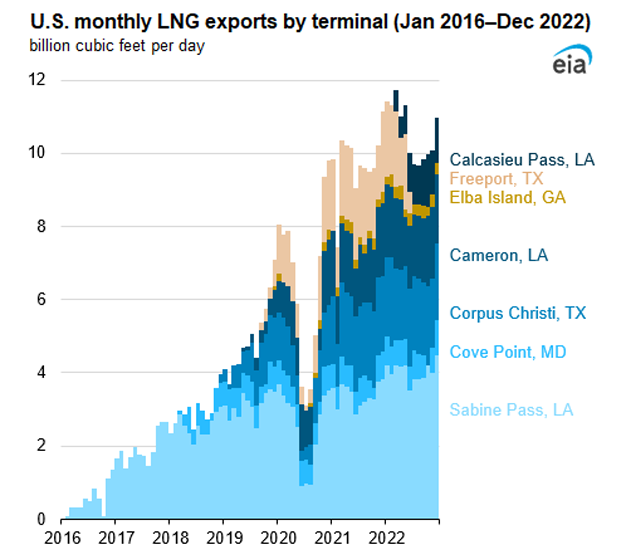
Data source: U.S. Energy Information Administration, Natural Gas Monthly
Note: LNG=liquefied natural gas
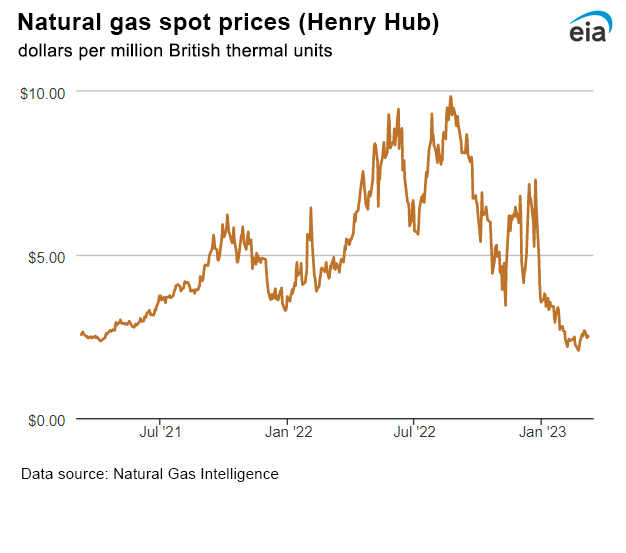
| Spot Prices ($/MMBtu) | Thu, 02-Mar |
Fri, 03-Mar |
Mon, 06-Mar |
Tue, 07-Mar |
Wed, 08-Mar |
|---|---|---|---|---|---|
| Henry Hub |
2.68 |
2.67 |
2.46 |
2.52 |
2.50 |
| New York |
2.64 |
2.49 |
2.69 |
2.55 |
2.45 |
| Chicago |
2.62 |
2.55 |
2.44 |
2.52 |
2.49 |
| Cal. Comp. Avg.* |
11.47 |
7.24 |
9.44 |
7.88 |
7.50 |
| Futures ($/MMBtu) | |||||
| April contract | 2.765 |
3.009 |
2.572 |
2.687 |
2.551 |
| May contract |
2.899 |
3.141 |
2.730 |
2.840 |
2.713 |
| *Avg. of NGI's reported prices for: Malin, PG&E Citygate, and Southern California Border Avg. | |||||
| Source: NGI's Daily Gas Price Index | |||||
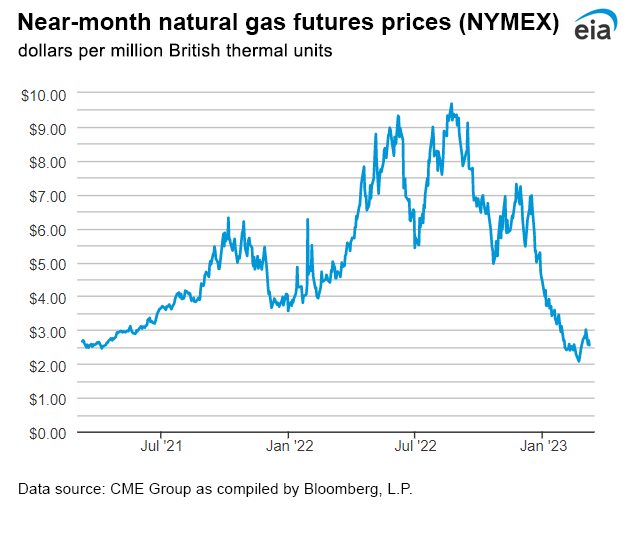
| U.S. natural gas supply - Gas Week: (3/2/23 - 3/8/23) | |||
|---|---|---|---|
Average daily values (billion cubic feet) |
|||
this week |
last week |
last year |
|
| Marketed production | 113.0 |
113.1 |
108.0 |
| Dry production | 100.7 |
100.8 |
95.3 |
| Net Canada imports | 4.3 |
5.0 |
4.8 |
| LNG pipeline deliveries | 0.1 |
0.1 |
0.1 |
| Total supply | 105.1 |
105.9 |
100.2 |
|
Data source: S&P Global Commodity Insights | |||
| U.S. natural gas consumption - Gas Week: (3/2/23 - 3/8/23) | |||
|---|---|---|---|
Average daily values (billion cubic feet) |
|||
this week |
last week |
last year |
|
| U.S. consumption | 85.1 |
91.2 |
80.3 |
| Power | 30.1 |
31.5 |
24.6 |
| Industrial | 23.6 |
23.9 |
24.1 |
| Residential/commercial | 31.3 |
35.9 |
31.6 |
| Mexico exports | 5.4 |
5.4 |
5.5 |
| Pipeline fuel use/losses | 7.2 |
7.4 |
6.9 |
| LNG pipeline receipts | 13.2 |
12.7 |
12.6 |
| Total demand | 110.9 |
116.7 |
105.2 |
|
Data source: S&P Global Commodity Insights | |||
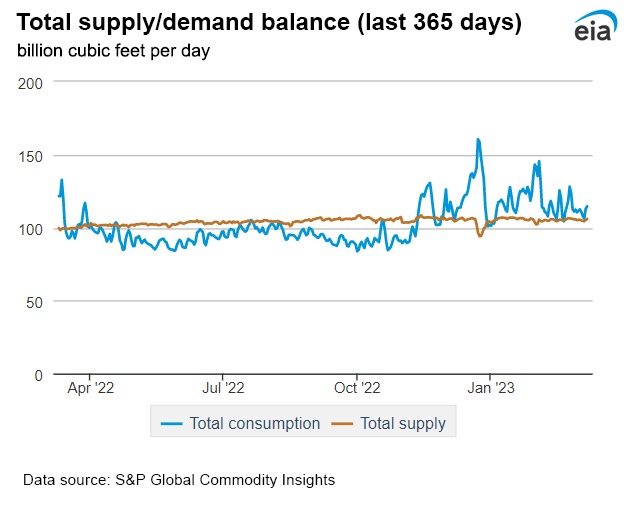
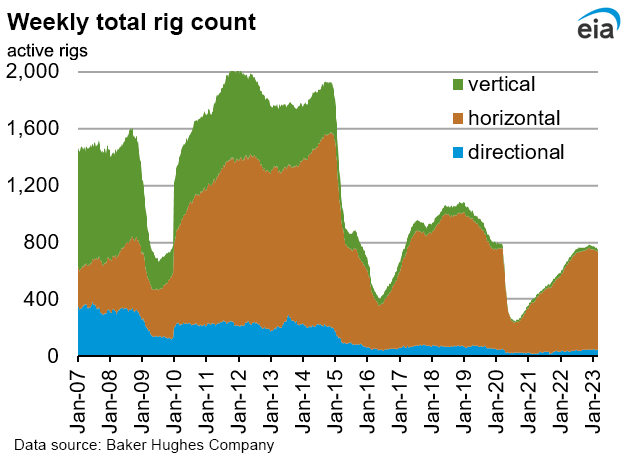
| Rigs | |||
|---|---|---|---|
Tue, February 28, 2023 |
Change from |
||
last week |
last year |
||
| Oil rigs | 592 |
-1.3% |
14.1% |
| Natural gas rigs | 154 |
2.0% |
18.5% |
| Note: Excludes any miscellaneous rigs | |||
| Rig numbers by type | |||
|---|---|---|---|
Tue, February 28, 2023 |
Change from |
||
last week |
last year |
||
| Vertical | 14 |
-12.5% |
-44.0% |
| Horizontal | 690 |
-0.4% |
16.0% |
| Directional | 45 |
2.3% |
50.0% |
| Data source: Baker Hughes Company | |||
| Working gas in underground storage | ||||
|---|---|---|---|---|
Stocks billion cubic feet (Bcf) |
||||
| Region | 2023-03-03 |
2023-02-24 |
change |
|
| East | 416 |
451 |
-35 |
|
| Midwest | 515 |
544 |
-29 |
|
| Mountain | 92 |
99 |
-7 |
|
| Pacific | 81 |
99 |
-18 |
|
| South Central | 925 |
922 |
3 |
|
| Total | 2,030 |
2,114 |
-84 |
|
| Data source: U.S. Energy Information Administration Form EIA-912, Weekly Underground Natural Gas Storage Report | ||||
| Working gas in underground storage | |||||
|---|---|---|---|---|---|
Historical comparisons |
|||||
Year ago (3/3/22) |
5-year average (2018-2022) |
||||
| Region | Stocks (Bcf) |
% change |
Stocks (Bcf) |
% change |
|
| East | 323 |
28.8 |
354 |
17.5 |
|
| Midwest | 370 |
39.2 |
411 |
25.3 |
|
| Mountain | 93 |
-1.1 |
95 |
-3.2 |
|
| Pacific | 162 |
-50.0 |
170 |
-52.4 |
|
| South Central | 587 |
57.6 |
640 |
44.5 |
|
| Total | 1,537 |
32.1 |
1,671 |
21.5 |
|
| Data source: U.S. Energy Information Administration Form EIA-912, Weekly Underground Natural Gas Storage Report | |||||
| Temperature – heating & cooling degree days (week ending Mar 02) | ||||||||
|---|---|---|---|---|---|---|---|---|
HDDs |
CDDs |
|||||||
| Region | Current total |
Deviation from normal |
Deviation from last year |
Current total |
Deviation from normal |
Deviation from last year |
||
| New England | 259 |
22 |
-15 |
0 |
0 |
0 |
||
| Middle Atlantic | 211 |
-12 |
-18 |
0 |
0 |
0 |
||
| E N Central | 199 |
-39 |
-40 |
0 |
0 |
0 |
||
| W N Central | 251 |
12 |
-11 |
0 |
0 |
0 |
||
| South Atlantic | 79 |
-61 |
-33 |
18 |
9 |
5 |
||
| E S Central | 58 |
-77 |
-76 |
5 |
2 |
5 |
||
| W S Central | 44 |
-43 |
-102 |
21 |
14 |
20 |
||
| Mountain | 227 |
46 |
15 |
0 |
-1 |
-1 |
||
| Pacific | 173 |
76 |
71 |
0 |
-1 |
0 |
||
| United States | 171 |
-6 |
-17 |
6 |
3 |
3 |
||
|
Data source: National Oceanic and Atmospheric Administration Note: HDDs=heating degree days; CDDs=cooling degree days | ||||||||
Average temperature (°F)
7-day mean ending Mar 02, 2023
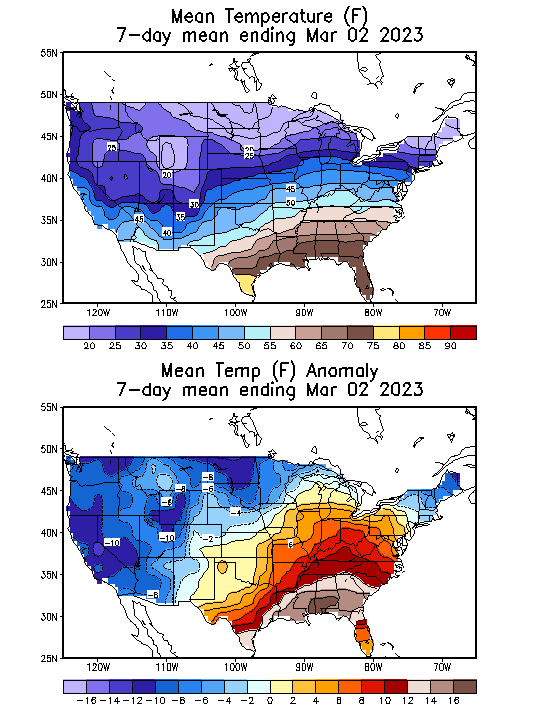
Data source: National Oceanic and Atmospheric Administration
Deviation between average and normal temperature (°F)
7-day mean ending Mar 02, 2023

Data source: National Oceanic and Atmospheric Administration

